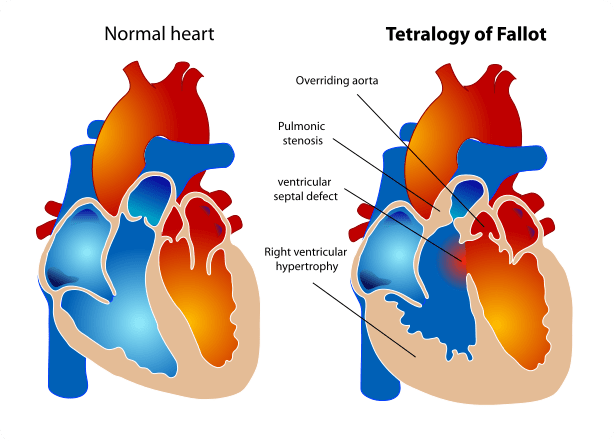Common Symptoms of Neonatal Tetralogy of Fallot with Absent Pulmonary Valve

Table of Contents
- Signs of Neonatal Tetralogy of Fallot with Absent Pulmonary Valve
- Diagnostic Tests for the Condition
- Potential Complications for Babies
- Treatment Options and Interventions
- Long
- term Prognosis and Outlook
Signs of Neonatal Tetralogy of Fallot with Absent Pulmonary Valve
Neonatal Tetralogy of Fallot with Absent Pulmonary Valve (TOF/APV) is a rare congenital heart defect that affects newborns. It is characterized by a combination of four heart abnormalities, including a ventricular septal defect, pulmonary valve stenosis, overriding aorta, and a non-functional or absent pulmonary valve. This condition leads to insufficient blood flow to the lungs, causing oxygen deprivation in the body. Recognizing the signs of TOF/APV early on is crucial for prompt medical intervention.
The common symptoms of neonatal TOF/APV may include:
- Cyanosis: Newborns with TOF/APV often exhibit bluish or purple discoloration of the skin, lips, and nail beds due to lack of oxygen.
- Rapid breathing: Infants may experience increased respiratory rates in an effort to compensate for the reduced oxygen levels.
- Poor feeding: Because of inadequate oxygen supply, babies may become tired and struggle to nurse or bottle-feed.
- Slow weight gain: Inadequate feeding can lead to poor weight gain, making it important to monitor a baby’s growth closely.
- Poor development: Oxygen deprivation can affect a child’s growth and development, leading to delays or difficulties in reaching developmental milestones.
- Irritability: Babies with TOF/APV may become fussy or irritable due to discomfort and lack of oxygen.
- Heart murmur: A healthcare provider may detect an abnormal heart sound during a physical examination. A heart murmur could indicate the presence of TOF/APV.
It is essential to seek immediate medical attention if these signs and symptoms are present. An early diagnosis and treatment plan can greatly improve the long-term prognosis for babies with TOF/APV. Treatment options may include surgical repair to correct the heart defects and ensure proper blood flow.
Parents of newborns with neonatal TOF/APV should work closely with a pediatric cardiologist to monitor their child’s condition and address any health concerns. Early intervention and ongoing medical management are key in providing the best possible outcomes for these infants.
Diagnostic Tests for the Condition
To diagnose Neonatal Tetralogy of Fallot with Absent Pulmonary Valve, a healthcare provider will conduct various diagnostic tests. These tests help confirm the presence of the condition and determine the severity of the heart defect. Some of the commonly used diagnostic procedures include:
- Echocardiogram: This non-invasive test uses sound waves to create a detailed image of the heart. It helps assess the structural abnormalities, blood flow, and functioning of the heart.
- Chest X-ray: X-rays can provide additional information about the heart and lungs’ size, shape, and overall condition. It helps identify any abnormalities or congestions in the pulmonary arteries and vessels.
- Electrocardiogram (ECG): An ECG records the electrical activity of the heart and can help identify abnormalities in the heart’s rhythm and rate. It can also indicate if the heart is enlarged.
- Cardiac MRI: Magnetic Resonance Imaging (MRI) provides detailed images of the heart’s structure and blood vessels. It helps evaluate the size and function of the heart, as well as the extent of the malformations.
- CT Scan: Computerized Tomography (CT) scans produce cross-sectional images of the heart and lungs. They help visualize the heart’s structures and determine the severity of the defects.
- Cardiac Catheterization: This procedure involves inserting a thin, flexible tube (catheter) into a blood vessel in the groin or arm and guiding it to the heart. It helps measure pressures and oxygen levels in the heart chambers and blood vessels, providing valuable information about the defects.
These diagnostic tests, in combination with a thorough physical examination and medical history review, allow healthcare professionals to make an accurate diagnosis of Neonatal Tetralogy of Fallot with Absent Pulmonary Valve. They also play a crucial role in determining the most appropriate treatment plan for each individual case, based on the severity of the condition.
It is important to note that only a qualified healthcare provider can interpret the results of these tests accurately. Therefore, if you suspect your child may have this condition, seeking medical attention and guidance is crucial for proper diagnosis and treatment.
Potential Complications for Babies
Neonatal Tetralogy of Fallot with Absent Pulmonary Valve is a complex congenital heart defect that can lead to several potential complications in babies. While the severity of these complications may vary from case to case, it is essential for parents and healthcare providers to be aware of them to ensure timely intervention and appropriate management.
Here are some potential complications associated with Neonatal Tetralogy of Fallot with Absent Pulmonary Valve:
- Pulmonary Regurgitation: Due to the absent pulmonary valve, regurgitation of blood from the pulmonary artery back into the right ventricle can occur. This can lead to enlargement of the right ventricle and increased strain on the heart.
- Heart Failure: The increased workload on the right side of the heart can potentially lead to heart failure in babies. Symptoms may include rapid breathing, poor feeding, and difficulty gaining weight.
- Cyanosis: Tetralogy of Fallot with Absent Pulmonary Valve can cause significant oxygen deprivation in the body, leading to cyanosis or bluish discoloration of the skin, lips, and nails. This occurs due to oxygen-poor blood being pumped to the body instead of the lungs.
- Poor Growth and Development: In severe cases, inadequate oxygen supply to the body can negatively impact a baby’s growth and development. This may result in delays in reaching developmental milestones.
- Infections: Babies with this heart defect may be at an increased risk for respiratory infections, such as pneumonia, due to compromised lung function.
- Arrhythmias: Irregular heart rhythms or arrhythmias can develop in babies with Neonatal Tetralogy of Fallot with Absent Pulmonary Valve. These abnormalities can further complicate the functioning of the heart and may require medical intervention.
It is important for parents and caregivers to closely monitor infants with Neonatal Tetralogy of Fallot with Absent Pulmonary Valve for any signs of these potential complications. Early detection, prompt medical interventions, and regular follow-up with a pediatric cardiologist can help manage these challenges effectively and optimize the baby’s overall well-being.
Treatment Options and Interventions
Neonatal Tetralogy of Fallot with Absent Pulmonary Valve (TOF-APV) requires immediate medical intervention to improve the baby’s condition and ensure their well-being. Treatment options and interventions for TOF-APV aim to address the symptoms and manage any complications that may arise. Here are the primary approaches:
- Surgical Repair: Surgery is the most common treatment for TOF-APV. The procedure involves correcting the heart defects, closing the ventricular septal defect (VSD), and restoring normal blood flow. Surgical repair helps improve the baby’s oxygen levels and reduces symptoms such as cyanosis and difficulty breathing.
- Pulmonary Valve Replacement: In cases where the absent pulmonary valve causes severe obstruction, a pulmonary valve replacement may be necessary. This procedure aims to restore proper blood flow by inserting an artificial valve to replace the absent or dysfunctional one.
- Palliative Measures: In some instances, where immediate surgical intervention is not feasible, palliative treatments may be used to stabilize the baby’s condition. These measures include medication to manage symptoms, such as diuretics to remove excess fluid, and oxygen therapy to increase oxygen levels in the blood.
- Postoperative Care: After surgery, strict postoperative care is essential for a successful recovery. This includes monitoring the baby’s vital signs, administering medication as prescribed, and conducting regular check-ups and tests to assess the heart’s function.
- Long-term Management: Following treatment, long-term management is crucial for babies with TOF-APV. Regular follow-ups with pediatric cardiologists are necessary to monitor their growth, development, and overall cardiac health. It is essential to ensure that any potential complications or recurring symptoms are detected and managed promptly.
Every case of TOF-APV is unique, and treatment plans may vary depending on the severity of the condition and individual factors. It is best to consult with a pediatric cardiologist who specializes in congenital heart defects for a comprehensive evaluation and personalized treatment plan for your baby.
Common Symptoms of Neonatal Tetralogy of Fallot with Absent Pulmonary Valve
Neonatal Tetralogy of Fallot with Absent Pulmonary Valve is a rare congenital heart defect that affects infants. It is characterized by four specific abnormalities in the heart’s structure, including a large hole between the ventricles, an overriding aorta, a thickened right ventricle, and a missing or underdeveloped pulmonary valve. This condition can cause a variety of symptoms, which can help identify affected infants:
- Blue coloration (cyanosis): One of the most prominent symptoms of neonatal Tetralogy of Fallot with Absent Pulmonary Valve is bluish skin or lips due to inadequate oxygen levels in the blood. This cyanosis may be apparent at birth or develop in the first few days of life.
- Rapid breathing and difficulty feeding: Infants with this condition may experience rapid breathing, also known as tachypnea, as well as difficulties in feeding. They may tire easily while feeding or require frequent breaks.
- Poor weight gain: Due to the increased energy expenditure associated with breathing difficulties and inadequate oxygen supply, infants with this condition may have poor weight gain or even experience weight loss.
- Failure to thrive: Neonates with Tetralogy of Fallot with Absent Pulmonary Valve may have difficulty thriving and meeting developmental milestones. Their growth and development may be significantly impacted by the condition.
- Murmurs: Doctors may detect abnormal heart sounds or murmurs during a physical examination. These murmurs are caused by the turbulent blood flow through the malformed heart structures.
If your newborn exhibits any of these symptoms, it is crucial to seek immediate medical attention. A timely diagnosis and appropriate management can help improve outcomes for infants with Neonatal Tetralogy of Fallot with Absent Pulmonary Valve. Early intervention may involve corrective surgeries to repair the heart’s abnormalities and ensure sufficient oxygenation of the blood.
Prognosis and Outlook
Neonatal Tetralogy of Fallot with Absent Pulmonary Valve (TOF/APV) is a complex congenital heart defect that may require extensive medical intervention. The prognosis and outlook for infants diagnosed with this condition can vary depending on several factors, including the severity of the defect, associated abnormalities, and the promptness of treatment.
Here is an overview of the possible long-term outcomes for neonates with TOF/APV:
- Medical management: Infants diagnosed with TOF/APV may require medical management and monitoring throughout their lives. Regular follow-ups with pediatric cardiologists are crucial to ensure proper growth, development, and management of any related complications.
- Surgical intervention: Surgical repair is typically necessary to correct the heart defects associated with TOF/APV. The appropriate timing and extent of surgery depend on the severity of the condition and the presence of associated abnormalities. Early surgical intervention is often required to optimize outcomes.
- Post-operative care: Following surgical correction, ongoing care is essential. This care includes regular cardiac check-ups, echocardiograms, and other diagnostic tests to monitor the progress and function of the repaired heart.
- Quality of life: With timely diagnosis, appropriate medical and surgical management, and regular follow-up care, many children born with TOF/APV can lead fulfilling lives. However, individual outcomes may vary, and some individuals may experience long-term complications that require continuous management.
- Potential complications: Although surgical repair improves the prognosis, there is a risk of complications, such as residual pulmonary artery stenosis, arrhythmias, pulmonary regurgitation, and infective endocarditis. Regular monitoring and medical attention can help identify and manage these potential complications effectively.
It is important to remember that each case is unique, and the overall prognosis for a child with TOF/APV depends on various factors. Early detection, appropriate medical care, and a multidisciplinary approach involving pediatric cardiologists, cardiac surgeons, and other healthcare professionals can significantly improve the long-term outlook for infants diagnosed with this complex condition.


























